
Lisson Gallery, London
14 September – 30 October 2021
by VERONICA SIMPSON
Marina Abramović is in London to launch a series of sculptures at the Lisson Gallery in Cork Street – an event not to be missed. She is an artist whose fame (and fortune) rest on her extraordinary ability to challenge us through her physical presence and her willingness to step outside the boundaries of what is usually acceptable between strangers, so it is not surprising that a decent show of arts writers have turned up and donned face masks to enter the gallery, lured by the prospect of meeting her. The sculptures are secondary – after all, sculpture is not what Abramović is known for. But, of course, it is no ordinary kind of sculpture she is showing here: it is a very new form that requires the investment of the viewer through their attention and movement.
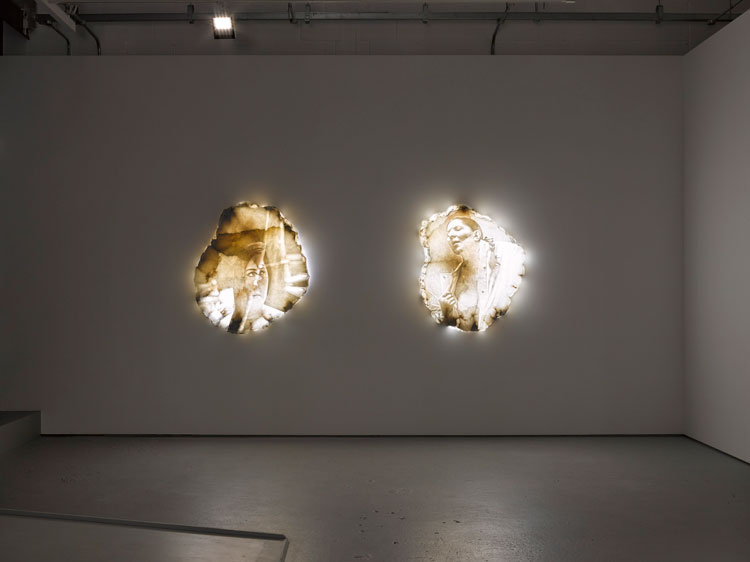
Marina Abramović: Seven Deaths, exhibition view, 22 Cork Street, London. 14 September – 17 October, 2021. © Marina Abramović, courtesy Lisson Gallery.
Against the blacked-out walls of the main gallery, seven alabaster shapes, lit from behind, appear to pulse with a spectral glow. Each one depicts Abramović acting out the final death scene from a famous opera in which the great diva Maria Callas is thought to have given the definitive performance. Abramović has made a film about Callas and these Seven Deaths, which you can see in the Lisson Street gallery, in which she herself plays Callas – though using Callas’s original recordings (Abramović admits that music is not her strong point). Through some almost magical process, the climactic images from these seven scenes have been transferred into alabaster, rendered 3D via the most delicate alabaster milling technique, using machinery refined over seven years of technological experimentation between Abramović and Factum Arte’s workshop in Madrid. The effect is hologrammatic: as you move past the “statues”, the imagery shifts from a layering of pencil-fine outlines into hyperreal, black-and-white, film-still clarity.
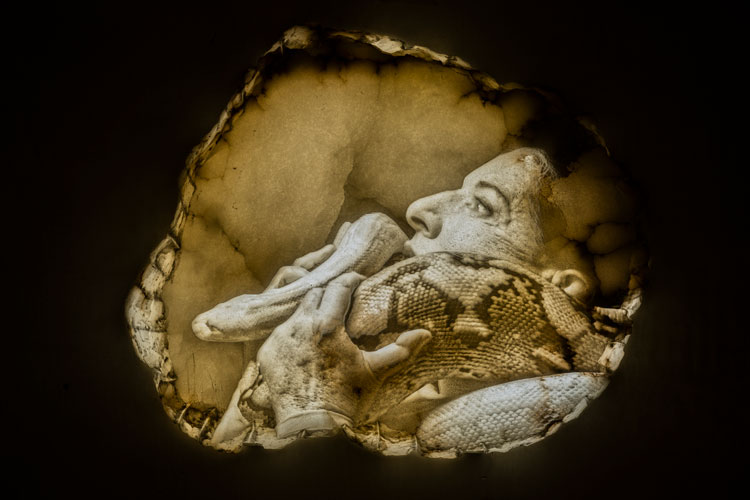
Marina Abramovic. Seven Deaths: The Snake, 2020/2021. Alabaster, custom light, 105 x 85 x 12 cm. © Marina Abramović, courtesy Lisson Gallery and Factum Arté. Photo: Oak Taylor-Smith.
Abramović’s talk with the assembled writers and critics – shown below – reveals a conversational style every bit as personal as her work, but also, at times, gloriously funny. Explaining her lifelong attachment to Callas - which began when, at the age of 14, the artist heard a recording in her grandmother’s kitchen – she says: “There were several reasons. Not just because she has the same nose as me, nor because she had a really bad mother like I did, not because she’s Sagittarius like I am, but also this incredible mixture between courage, strength and ability … she was so strong on stage and so emotional, and lonely and unhappy in her life. That was kind of an interesting mix. And the fact that really, she died for love.”
Happily, she says, she does not share that latter aspect, with Callas. Although she was deeply in love with her famous co-performer Frank Uwe Laysiepen, known as Ulay, for many years, when that relationship ended, her passion for work saved her, she tells us. Perhaps in a poetic way, by re-enacting those iconic moments where Callas dies for love, Abramović is ritually celebrating her own lust for life, giving thanks for her work, as both purpose and salvation.
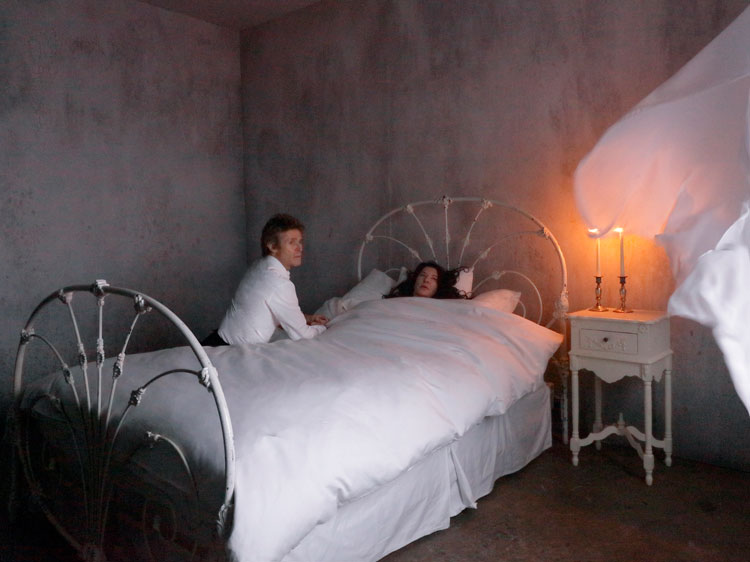
Marina Abramović, 7 Deaths of Maria Callas, 2019. Photo: Marco Anelli, Courtesy of the Marina Abramovic Archives.
Her Callas obsession has fuelled her work in recent years. She has now created a full-scale, live-action opera around the same theme – Seven Deaths of Maria Callas – which opened in Paris this autumn, then visits Athens, and will be in Berlin and Milan for 2022. She begins her talk in London by expressing the hope that it could be staged at the Royal Opera House in Covent Garden, because Callas loved Covent Garden. Directing opera is certainly a new art form for her, as is sculpture – a project she seemed very unsure of judging by what she says she told Factum Arte: “Performance art is an immaterial form – I can’t go there and make marble pieces. It would be totally a contradiction. And to make something to please the market, I don’t want that. I want something that has material and immaterial elements inside, life and death (at) the same time.”
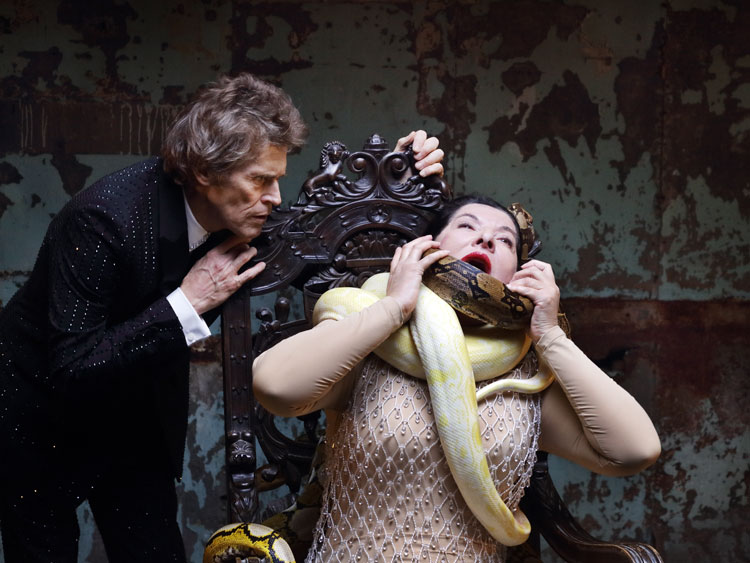
Marina Abramović, 7 Deaths of Maria Callas, 2019. Photo: Marco Anelli, Courtesy of the Marina Abramovic Archives.
Because these moments captured by the sculptures are taken from the actual filmed scenes, Abramovic claims them as an extension of her performance. But where the sculptures are intriguing, beautiful and tactile (she encourages us to touch them, as she herself does), the filmed part is – to me – less successful. For all that Abramović manages to maintain great intensity and gravity as she acts out Lucia di Lammermoor smashing mirrors to shards – one of which finally kills her – or Carmen (cross-dressing as a bullfighter, rather than a sultry siren) being gored by her nemesis (played, as in all the partnered scenes by Willem Dafoe), there is no respite in the long, slow burn of intense melodrama to each scene. And each death seems to take a good 10 to 15 minutes (and feels twice as long). Just witnessing two or three is exhausting – apart from the rare, and possibly unintentional, moment of comedy in Norma, in which Dafoe and Abramović swap genders and it’s Dafoe in a glittering gold dress who walks into the flames, with Abramović in full tuxedo.
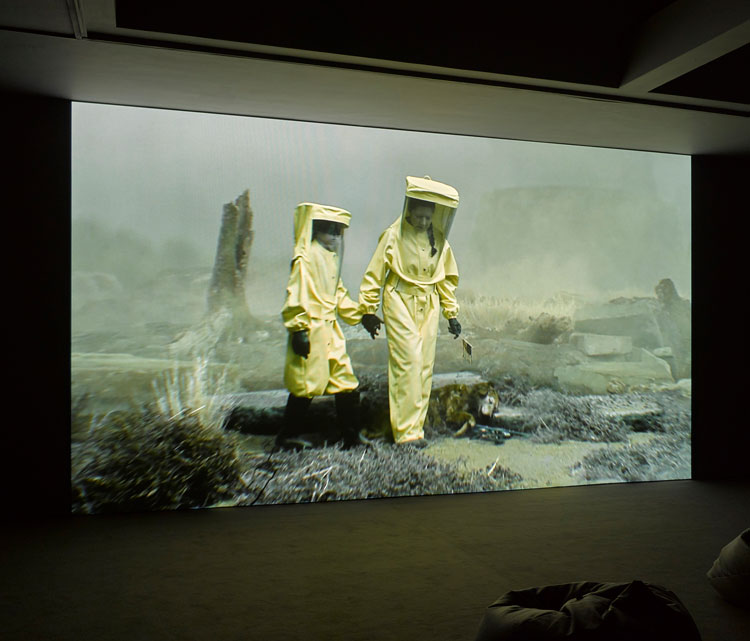
Marina Abramović: Seven Deaths, installation view, Lisson Gallery, Lisson Street, London, 14 September – 30 October 2021 © Marina Abramović, courtesy Lisson Gallery.
For the most part, the scenes are played out too slowly and too literally, apart from an unusual rendition of Madame Butterfly, set in some toxic, post-apocalyptic landscape, in which Abramović kills herself by ripping open her hazmat suit. In this, the lush operatic soundscape creates a thrilling contrast with the bleached out, sci-fi scene she presents, as she takes her last poisonous breaths.
After this intense concentration on Callas and calamity, Abramović declares: “I am definitely finished with dying.” She promises us that her show at the Royal Academy – originally scheduled for 2020 but now postponed until 2023 – will be called After Life.
The loss of an icon is ever of great note but that the iconoclast architect Frank Gehry’s passing ...
Luigi Ghirri: Polaroid ’79-’83
Luigi Ghirri’s spell using Polaroid cameras takes us on an imaginary adventure, with leading clues...
A groundbreaking exhibition turns the way we think about sculpture on its head. Every object has its...
Photographer Merlin Daleman talks about how his new photo book, Mutiny, captures the backstory of th...
Three seductive, spellbinding films demonstrate the Uzbek artist and film-maker Saodat Ismailova’s...
German painter Gerhard Richter enchants, astonishes and unnerves in this compendious retrospective, ...
Karimah Ashadu’s three films may aim to give a voice to marginalised men in the former British col...
Playing with Fire: Edmund de Waal and Axel Salto
The artist and author Edmund de Waal has curated the first major exhibition of the Danish ceramicist...
Women of Influence: The Pattle Sisters
Seven sisters made their mark on Victorian art and culture and deserve to be far more than just dist...
Anindita Dutta: The Shadows of Duality
Shifting from her usual clay to recycled shoes, animal hides, fur, fabrics and more, Anindita Dutta ...
Berthe Weill: Art Dealer of the Parisian Avant-garde
This milestone exhibition celebrates the pioneering art dealer Berthe Weill, who launched the career...
Artes Visuales: The Latin American Avant-Garde in Print
Focusing on the influential Artes Visuales magazine and the extraordinary experimental artists it fe...
Rae-Yen Song 宋瑞渊, •~TUA~• 大眼 •~MAK~•
This is a theatrical space like no other in which, using sculpture, sound, textiles and performance,...
Celebrating the photographic work of Lee Miller in grand style, this retrospective showcases her man...
Now in her 70s, and with a show at the Irish Museum of Modern Art in Dublin, Cecilia Vicuña’s act...
Jaune Quick-to-See Smith: Wilding
This posthumous exhibition of Jaune Quick-to-See Smith’s art includes work made right up to her de...
Ayoung Kim: Delivery Dancer Codex
A trilogy of video works featuring two queer, female delivery drivers in Seoul, Ayoung Kim’s Deliv...
The Tate’s landmark exhibition presents a fascinating story, but could have done more to capture t...
Known as a gallerist to the likes of Rauschenberg and Rothko, Betty Parsons spent her weekends makin...
In a powerful new show of painting, sculpture and film, the artist brings folkloric traditions and m...
Robert MacBryde and Robert Colquhoun: Artists, Lovers, Outsiders
The two men from working-class Scottish backgrounds met at art school and became inseparable. This e...
Push the Limits: Culture Strips to Reveal War
A diverse group of works in this exhibition at Fondazione Merz show how contemporary art responds to...
Artes Mundi 11 Prize and Exhibition
Against a background of divisive global politics and hysteria around migration, the six artists shor...
At Aberystwyth Arts Centre, Anawana Haloba has staged an “experimental opera”, as she terms this...
Jumana Emil Abboud – interview
Drawing on folklore, mythmaking and storytelling, Jumana Emil Abboud articulates the strains placed ...
Rhiannon Hiles, chief executive, Beamish Museum – interview
Winner of the world’s largest museum prize, the £120,000 Art Fund Museum of the Year, Beamish, an...
Whether depicting women at work, children playing on the beach or locals at prayer Anna Ancher’s l...
Wright of Derby: From the Shadows
The National Gallery reunifies Joseph Wright of Derby’s trio of candlelit masterpieces, while reve...
Wayne Thiebaud: American Still Life
A luscious selection of sweets, cakes and pies seduce us at this, American painter Wayne Thiebaud’...
A Story of South Asian Art: Mrinalini Mukherjee and Her Circle
This visually thrilling exhibition is a revelation. Pivoting around Mrinalini Mukherjee, it also cel...